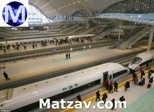 [Photos below.] In the week that Britain’s high speed rail link closed down because the wrong sort of snow interfered with the engine’s electronics, China unveiled the world’s fastest train service on one of the coldest days of the year.
[Photos below.] In the week that Britain’s high speed rail link closed down because the wrong sort of snow interfered with the engine’s electronics, China unveiled the world’s fastest train service on one of the coldest days of the year.
Days after thousands of passengers were left stranded when Eurostar services were cancelled, China’s new system connects the modern cities of Guangzhou and Wuhan at an average speed of 217mph – and it took just four years to build.
The super-high-speed train reduces the 664-mile journey to just a three-hour ride and cuts the previous journey time by more than seven-and-a-half hours, the official Xinhua news agency said.
Work on the project began in 2005 as part of plans to expand a high-speed network aimed at eventually linking Guangzhou, a business hub in southern China near Hong Kong, with the capital Beijing, Xinhua added.
“The train can go 245mph; it’s the fastest train in operation in the world,” said Zhang Shuguang, head of the transport bureau at the railways ministry.
Test runs for the service began earlier in December and the link officially went into service when the first scheduled train left the eastern metropolis of Wuhan this past weekend.
By comparison, the average for high-speed trains in Japan was 150mph while in France it was 172mph, said Xu Fangliang, general engineer in charge of designing the link.
Beijing has an ambitious rail development programme aimed at increasing the national network from the current 53,437 miles to 74,564 miles, making it the most extensive rail system outside the United States.
China unveiled its first high-speed line at the time of the Beijing Olympics in 2008 – a service linking the capital with the port city of Tianjin.
In September, officials said they planned to build 42 high-speed lines by 2012 in a massive system overhaul as part of efforts to spur economic growth amid the global downturn.
The network uses technology developed in co-operation with foreign firms such as Siemens, Bombardier and Alstom.
Tickets for the service – which also stops at Changsha, capital of Hunan – went on sale at new stations in the three cities last weekend, with prices ranging from 780 yuan (£71) for first class to 490 yuan (£45) for second class, said a joint document released by the National Development.
“High-speed rail has three advantages over air travel: it is more convenient, more punctual and has a better safety record. This could help erode the airlines’ market shares,” said Si Xianmin, chairman of China Southern Airlines, the largest domestic airline by fleet size.
From this past weekend’s launch, 38 out of China Southern Airlines’ 160-plus domestic flights will compete with high-speed train links, he said.
A similar service opened on April 1 between Wuhan and Hefei, Anhui province, had already grabbed half of the passengers traveling from Wuhan to Shanghai, said Si.
If railway chiefs over-cut the number of low-cost tickets on slower trains, as they did when the country’s first high-speed link opened between Beijing and Tianjin last year, the airlines could win more passengers with cheap offers, said Zhao Jian, professor with Beijing Jiaotong University.
‘But whichever side wins, passengers will be the ultimate winner,’ he said.
Wu Wenhua, a researcher with the National Development and Reform Commission’s comprehensive transport institute, said developing high-speed rail networks is in line with the demand for high-efficiency, low-emissions transport.
For photos of the train, see below:
[slideshow id=96]
{Daily Mail/Matzav.com Newscenter}












The only problem is the plastic seats are toxic, the metal wheels are made of contaminated steel and will break after 10,000 hours of use, and the rivets are made of weak aluminum. Oh boy, they are in for it !!!